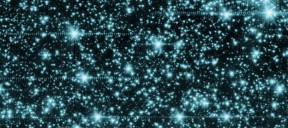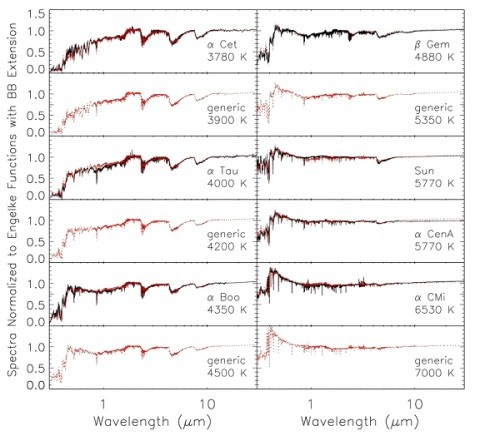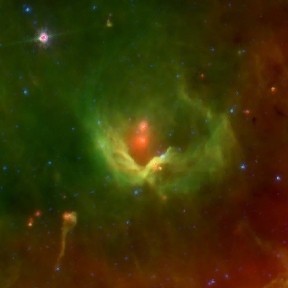Astrophysical Studies at ISR
Researchers at the Institute for Scientific Research study the infrared properties of evolved stars and star-forming regions in the Milky Way and nearby galaxies, such as the Large and Small Magellanic Clouds. We are also engaged in improving the spectroscopic and photometric reliabilty of the stellar spectra that are used for to calibrate space- and ground-based telescopes.

Stellar Calibration
Calibrating visible and infrared sensors on stars is a common step for any instrument which observes faint point-sources. Stars are scattered conveniently over the sky, are accessible simultaneously to multiple observers, may be revisited at intervals in order to track and characterize any changes in instrument response, and exhibit long term continuity which allows archived observations to share a baseline of comparison with observations made using current and future instruments. The quality of this shared calibration, however, depends in any particular time period on the quality of our knowledge of the spectral energy distributions (SEDs) of the reference stars observed.
Work at ISR has focused on progressively refining and updating knowledge of the visible-through-infrared spectra of commonly observed standard stars using all available strands of information. This effort brings together and cross-correlates theoretical modeling, data from various calibration experiments, exoatmospheric spectrometry (e.g., ESA’s ISO SWS, HST’s STIS & NICMOS, Spitzer's IRS) and relative photometry (e.g., DIRBE, MSX, Hipparcos, Spitzer's IRAC & MIPS, WISE) taken from satellite observatories, as well as the large ground databases of relative magnitude comparisons between types of stars. These data are culled, reanalyzed and reconsidered in light of subsequent information, such as evidence of variability in the traditional primary standard Vega. The results are synthesized into continuous composite spectra (i.e. SEDs stored as computer files) which constitute the best available estimate of each standard star’s absolute spectral calibration.
Such absolutely calibrated “composite” spectra for stars of various temperatures are then used to find a best-fit function of temperature at each catalogued wavelength which generates the mean predicted template spectral shape for a star of any temperature in the range covered by the original standard stars. These can be used to represent stars which have had no direct continuous spectrometry performed on them, greatly expanding the range of stars which can become calibrators in the sky. We have created some 500 calibrators with continuous visible to infrared SEDs in this manner.

The figure above shows some sample composite spectra of specific standard stars (black lines) and our computer generated generic templates (red dotted lines) for temperatures corresponding to those of the standards and for stars of intermediate temperatures. In each case the flux is normalized to a continuum and shown plotted against wavelength (0.3 µm - 35 µm) on a logarithmic scale.
Selected Publications
Rieke, G. H., Engelke, C., Su, K., & Casagrande, L., 2023, Astron. J., 165, 99, Absolute Calibration. III. Improved Absolute Calibration for the Visible through the Mid-infrared
Kraemer, K. E., Engelke, C. W., Renger, B. A., & Sloan, G. C. 2022, "Tying Spitzer’s IRS Calibration to IRAC: Observations of IRS Standard Stars," Astron. J., 164, 161. DOI
Gordon, K. D., Bohlin, R., Sloan, G. C., et al. 2022, "The James Webb Space Telescope Absolute Flux Calibration. I. Program Design and Calibration Stars" Astron. J., 163, 267. DOI
Sloan, G. C., Goes, C., Ramirez, R. M., Kraemer, K. E., & Engelke, C. W. 2015, "Infrared Spectral Porperites of M Giants," ApJ, 811, #11. DOI
Carey, S., Ingalls, J., Hora, J., et al. 2012, "Absolute Photometry Calibration of IRAC: lessons learned using nine years of flight data," ProcSPIE, 8442, 84421Z. DOI
Engelke, C. W., Price, S. D., & Kraemer, K. E. 2010, “Spectral Irradiance Calibration in the Infrared. XVII. Zero-magnitude Broadband Flux Reference for Visible-to-infrared Photometry,” AJ, 140, 1919-1928. DOI.
Engelke, C. W., Price, S. D., & Kraemer, K. E. 2006, “Spectral Irradiance Calibration in the Infrared. XVI. Improved Accuracy in the Infrared Spectra of the Secondary and Tertiary Standard Calibration Stars,” AJ, 132, 1445-1463. DOI.
Price, S. D., Paxson, C., Engelke, C., & Murdock, T. L. 2004, “Spectral Irradiance Calibration in the Infrared. XV. Absolute Calibration of Standard Stars by Experiments on the Midcourse Space Experiment,” AJ, 128, 889-910. DOI.
Point of Contact for this project is Charles Engelke.

Astronomy Research
ISR personnel have led the image processing efforts for several recent infrared space-based astronomy surveys. Dust grains in our Milky Way and other galaxies absorb ultraviolet and visible light and re-emit it in the infrared. Thus, the infrared surveys trace the location of the dust, such as in giant molecular clouds. It is within the dense cores of these clouds, such as the Orion nebula or the Cygnus-X star forming region (right), that new stars are being formed. The young stars are also bright in the infrared as the the newly formed star heats the remnants of the core from which it formed (& perhaps its planetary system). The Celestial Backgrounds projects on the DoD's Midcourse Space Experiment mapped the Galactic plane at 4, 8, 12, 14, and 23 microns, as well as several star forming clouds and other galaxies. The ISR produced the 24 micron survey for Spitzer's MIPSGAL program, which also mapped the Galactic plane, and the Cygnus-X Legacy program which mapped the richest nearby massive star forming region. We recently concluded a project that mapped the Small Magellanic Cloud for the last time with Spitzer's IRAC. The team has just begun a new project to create maps and star catalogs of several nearby dwarf galaxies that were imaged with Spitzer in the infrared.
In addition to dusty clouds and very young stars, cool stars and older, evolved stars can be brighter in the infrared than the visible. The cool stars with K and M spectral types tend to be bright in the infrared, with temperatures of ~2000-5000 K. Their relatively simple spectra and photometric stability make them suitable as calibration standards. Although some are variable at visible wavelengths, the majority show little or no variation in the infrared. As part of the stellar calibration program, we are investigating where the transition occurs, from variable in the visible to stable in the infrared.

The older, evolved stars are bright in the infrared in part because they are actually producing new dust in their cool, extended atmospheres. The fusion products created deep in the stellar interiors have been dredged up to the atmospheres, including carbon, oxygen, and other elements heavier than hydrogen and helium, termed 'metals'. As the stars die, their atmospheres pulsate and expand, ultimately injecting the new dust and metals back into the clouds from which new stars will form, thus enriching the interstellar medium, We are studying the dust around evolved stars in the nearby Magellanic Clouds and other small satellite galaxies where the enrichment has not been as efficient as in the Milky Way. These 'metal-poor' systems can be used as surrogates to much older, more distant galaxies in the early Universe, which are much harder to study.
Current projects are using data from NASA's James Webb Space Telescope, including studies of the Galactic planetary nebula NGC 3602 (PID 1742, PI M. Matsuura), calibration standard stars (PID 2050, PI G. Sloan), carbon stars in the Large Magellanic Cloud (PID 3010, PI G. Sloan), the planetary nebula in the Fornax galaxy (PID 5141, PI K. Kraemer).
Select Publications
Kuchar, T. A., Sloan, G. C., Mizuno, D. R., Kraemer, K. E., Boyer, M. L., Groenewegen, M. A. T., Jones, O. C., Kemper, F., McDonald, I., Oliveira, J. M., Sewiło, M., Srinivasan, S., van Loon, J. Th., & Zijlstra, A., 2024, SMC-Last Extracted Photometry, Astron. J., 167 149,
Mizuno, D. R., Kuchar, T. A., Kraemer, K. E., & Sloan, G. C. 2022, SMC-Last Mosaic Images, Pub. Astron. Soc. Pacific, 134, 094101
Kraemer, K. E., Sloan, G. C., Keller, L. D., McDonald, I., Zijlstra, A. A., & Groenewegen, M. A. T. 2019, Stellar Pulsation and the Production of Dust and Molecules in Galactic Carbon Stars, ApJ, 887, 82
Kraemer, K. E., Sloan, G. C., Jones, O. C., et al. 2017, "Characterizing the Population of Bright Infrared Sources in the Small Magellanic Cloud," ApJ, 834, 185. ADS, DOI.
Sloan, G. C., Kraemer, K. E., McDonald, I., et al. 2016, "The Infrared Spectral Properties of Magellanic Carbon Stars," ApJ, 826, 44
Sloan, G. C., Goes, C. W., Ramirez, R., Kraemer, K. E., & Engelke, C. W. 2015, "Infrared Spectroscopy of M Giants,'' ApJ, 811, 45
Ryan, E. L., Mizuno, D. R., Shenoy, S. S., Woodward, C. E., Carey, S. J., Noriega-Crespo, A., Kraemer, K. E., & Price, S. D. 2015, "The kilometer-sized Main Belt asteroid population revealed by Spitzer,'' A&A, 578, A42
Sloan, G. C., et al. 2012, “Carbon-rich dust production in metal-poor galaxies in the Local Group,” ApJ, 752, 140. ADS, DOI.
Price, S. D. 2011, “The AFCRL Lunar and Planetary Research Branch,” J. Astr. History & Heritage, 14, 115-128. ADS.
Price, S. D., Smith, B. J., Kuchar, T. A., Mizuno, D. R., & Kraemer, K. E. 2010, “3.6 Years of DIRBE Near-infrared Stellar Light Curves,” ApJS, 190, 203-219. ADS, DOI.
Sloan, G. C., et al. 2010, “Spitzer Spectroscopy of Mass-loss and Dust Production by Evolved Stars in Globular Clusters,” ApJ, 719, 1274-1292. ADS, DOI.
McDonald, I., et al. 2010, “Rusty Old Stars: A Source of the Missing Interstellar Iron?” ApJL, 717, L92-L97. ADS, DOI.
Kraemer, K. E., et al. 2010, “Circumstellar Structure Around Evolved Stars in the Cygnus-X Star Formation Region,” AJ, 139, 2319-2310. ADS, DOI.
Mizuno, D. R., et al. 2010, “A Catalog of MIPSGAL Disk and Ring Sources,” AJ, 139, 1542-1552. ADS, DOI.
Carey, S. J., et al. 2009, “MIPSGAL: A Survey of the Inner Galactic Plane at 24 and 70 µm,” PASP, 121, 76-97. ADS, DOI.
Sloan, G. C., et al. 2008, “The Magellanic Zoo: Mid-Infrared Spitzer Spectroscopy of Evolved Stars and Circumstellar Dust in the Magellanic Clouds,” ApJ, 686, 1056-1081. ADS, DOI.
Mizuno, D. R., et al. 2008, “Processing for the MIPSGAL 24 µm Survey of the Inner Galactic Plane,” PASP, 120, 1028-1042. ADS, DOI.
Point of contact for this project is Kathleen Kraemer.

